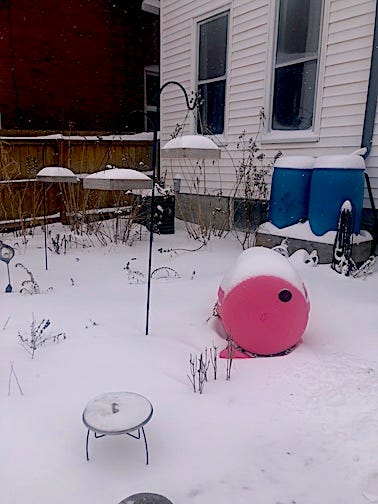Garden gear: Our top 5 for Prime Day
And why you should't feel guilty about shopping at Amazon.


By Lisa Brunette
Shilling for product is not something we feel especially called to do, which is why the Substack subscription model appeals to us. If you find value here and enjoy reading without the distraction of annoying popups and auto-play videos, you can choose to pay for this experience if you like.
But people often ask us for recommendations, and we also know certain garden gear really comes in handy, making work easier and solving problems. So we’ve pulled together this list of our top five items for your garden.
We’ve included Amazon links below1. You shouldn’t at all feel guilty about buying through Amazon. We’re all living in a society in which our political/corporate overlords decided it was to their advantage to offshore manufacturing to places with fewer labor rights and environmental controls. Amazon took advantage of the situation and dominated the market with tough-to-beat prices and free delivery. Our salaries have stagnated for the past 50 years, so we’re all making the best decisions we can with our earnings. I chose to give you these recommendations now because tomorrow is Prime Day (actually runs July 11-12), which might provide you with even better prices than usual.
This is not to say that we shouldn’t buy local if we can. Anthony and I fill in the gaps in our garden via a local farmer’s market, buy meat from a local rancher, and shop local for consumer goods when feasible. I tried committing to the shop-local thing 100 percent when I lived in Seattle, though, and I quickly saw how futile this is when the only jeans to be had “locally” were priced at 200 bucks… a leg. My paycheck didn’t justify the expense, and I didn’t want to lose an appendage even for some pretty nice denims. Oh, I mean dungarees.
The Broadfork—Made in USA.
I first learned about the broadfork through a conversation about permaculture and the no-till gardening method. Anthony and I do not till our garden, have never tilled our garden, and do not recommend it. Instead, we broadfork it, which is much less damaging to the mycorrhizal fungi and other soil structures. It’s also less work, making it a win-win in our book. So get yourself a broadfork and go to town.
I call them the “Barbie big wheels,” but those hot pink tumbleweeds in the image above are composters. I mean “the cutest composters in the world.”
Anthony and I discovered EnviroCycle Composters after a deep dive into all things composting. Yes, they are on the high side, price-wise. But I guarantee you that if we had purchased a lesser composter, we’d have gone through three or four of them by now, making the expense more than justified. In other words, you could get a rotating composter for 50 bucks, it will fall apart in the middle of your first gardening season, and you will end up buying this one anyway.



There are two sizes, a small one at 17 gallons, and the larger at 35. We bought the small one, wished we’d purchased the larger, and now we have both. So if you think you need the large one, just go for it.
Can’t do Barbie pink? I love it for a pop of color, especially in winter! But I once painted the exterior of my home orange and realize not everyone wants modern art in their yard. They also offer black.
These fences are the whole reason for this list, as over the past month I’ve been in conversation with both Erin Hanson of The Suburb Farm and Bill Bishop of Sinocism about modular fencing, and I promised them I’d write up the ones we use.



You’ll notice above I’ve linked to the exact product we purchased from Menard’s (not an affiliate link). We bought ours over 2-3 years in the physical store when they went on clearance in the fall, post-garden season. You can find similar fences via Amazon (affiliate link).
Platform Bird Feeders—Made in USA.
No-fuss, sturdy bird feeders. We’ve had these for five years, and they’re still going strong. Sure, squirrels can easily catapult their way into them, but I’ve never minded the squirrels, and the birds don’t seem to, either. They just take turns. Don’t forget to clean the feeders with a 1:9 ratio of vinegar to water and a wire brush.


Solar Oven—Made in USA.
During the Sustainable Backyard Tour, we demo’d the Sun Oven. Or rather, we demonstrated the limits of solar energy, as it was rainy and overcast that day, and our solar oven only got up to about 125°F, not hot enough to cook anything.
But as you can see here, solar ovens do work. When the sun is shining. Yes, even if the ground is covered in snow. It would work even better on a sunny day like that, in fact, as I believe the snow would reflect more sunlight back onto the solar oven.


Here’s why you need a solar oven: 1) emergencies 2) energy savings 3) baking in summer when it’s otherwise too hot and you don’t want to heat up your house. Also, cooking solely with the power of the sun is kind of amazing.
As you can see, we regularly use all of these items and can vouch for them. I hope they make your gardening life easier and more rewarding, as they have done for us.
If you purchase using the links, Brunette Gardens might earn a small commission, at no extra cost to you. Please also see our affiliate link policy.




Any gear recommendations to add to the list?
Thanks, Lisa! I appreciate your help in our battle of the bunnies.
I completely agree with you on the Amazon thing. Wage stagnation is legit and we do what we can to support local, but going 100% local or handmade isn't affordable or even possible for most of us.